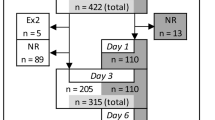Abstract
Objectives
The aim of the study was to find out whether and to what extent the performance of dentists regarding diagnostic evaluation of dental radiographs is influenced by symptoms of fatigue.
Materials and methods
Over a period of 40 minutes, 21 dentists evaluated a database of 96 randomly selected, infinitely repeating intraoral dental radiographs for the presence of periapical radiolucencies. Both before and after, participants were asked to assess their subjective fatigue using the Swedish Occupational Fatigue Inventory (SOFI), Visual Analogue Scale (VAS), and Numerical Rating Scale (NRS). Diagnostic accuracy was analyzed using the Receiver Operating Characteristics (ROC) method. Furthermore, the correlation between diagnostic accuracy and radiographic experience, image viewing time, and level of training was also evaluated.
Results
The study showed that despite increasing fatigue, the diagnostic accuracy of the examiners remained consistent with an average AUC value of 0.768 ± 0.091. Within the 40-min reporting period, no statistically significant fluctuations were found. The diagnostic accuracy varied depending on the radiographic experience: with many years of radiographic experience, the diagnostic accuracy increased. At the same time, the older study participants with greater radiographic experience became less tired compared to younger study participants during the examination.
Conclusions
Although an increase in fatigue was observed during the 40-min examination, the diagnostic accuracy of the doctors remained constant.
Clinical relevance
Due to the high workload which needs to be handled in a limited time, medical and dental professionals have reached a certain level of exposition to stress that can lead to physical fatigue. However, the increasing fatigue should not negatively influence the work of the doctors. The study shows that the radiodiagnostic accuracy remained the same.






Similar content being viewed by others
References
Thapa R et al (2021) The development and psychometric properties of oral health assessment instruments used by non-dental professionals for nursing home residents: a systematic review. BMC Geriatr 21:1 35
Shahrabani S (2019) Factors affecting oral examinations and dental treatments among older adults in Israel. Isr J Health Policy Res 8:1 43
Mejàre IA, Axelsson S, Davidson T, Frisk F, Hakeberg M, Kvist T, Norlund A, Petersson A, Portenier I, Sandberg H, Tranæus S, Bergenholtz G (2012) Diagnosis of the condition of the dental pulp: a systematic review. Int Endod J 45:597–613
Rötzscher K (2003) Forensische Zahnmedizin. Springer Verlag: s.n.
Iannucci J, Howerton LJ (2016) Dental radiography - E-Book: principles and techniques. s.l.: Elsevier Health Sciences
Sokolovskaya E, Shinde T, Ruchman RB, Kwak AJ, Lu S, Shariff YK, Wiggins EF, Talangbayan L (2015) The effect of faster reporting speed for imaging studies on the number of misses and interpretation errors: a pilot study. J Am Coll Radiol 12:683–688
Krupinski EA, Berbaum KS, Caldwell RT, Schartz KM, Kim J (2010) Long radiology workdays reduce detection and accommodation accuracy. J Am Coll Radiol 7:698–704
Krupinski EA, Berbaum KS (2009) Measurement of visual strain in radiologists. Acad Radiol 9
Krupinski EA, Berbaum KS, Caldwell RT, Schartz KM, Madsen MT, Kramer DJ (2012) Do long radiology workdays affect nodule detection in dynamic ct interpretation? J Am Coll Radiol 9
Krupinski EA (2010) Reader fatigue interpreting mammograms. s.l.: Springer-Verlag Berlin Heidelberg
Burling D, Halligan S, Altman DG, Atkin W, Bartram C, Fenlon H et al (2006) CT colonography interpretation times: effect of reader experience, fatigue, and scan findings in a multi-centre setting. Eur Radiol 16
Bechtold RE, Chen MYM, Ott DJ, Zagoria RJ, Scharling ES, Wolfman NT et al (1997) Interpretation of abdominal CT: analysis of errors and their causes. J Comput Assist Tomogr Vol 21
González Gutiérrez JL, Jiménez BM, Hernández EG, López López A (2005) Spanish version of the Swedish Occupational Fatigue Inventory (SOFI): factorial replication, reliability and validity. Int J Ind Ergon 35(8):737–746
R, Team (2017) A language and environment for statistical computing. [Online]. http://www.R-project.org/
Hanna TN, Lamoureux C, Krupinski EA, Weber S, Johnson JO (2017) Effect of shift, schedule, and volume on interpretive accuracy: a retrospective analysis of 2.9 million radiologic examinations. Radiology
Maeda E, Yoshikawa T, Hayashi N, Akai H, Hanaoka S, Sasaki H, Matsuda I, Yoshioka N, Ohtomo K (2011) Radiology reading-caused fatigue and measurement of eye strain with critical flicker fusion frequency. Jpn J Radiol 29:483–487
Alpert HR, Hillman BJ (2004) Quality and variability in diagnostic radiology. J Am Coll Radiol 1(2):127–132
Robinson PJ (1997) Radiology’s Achilles’ heel: error and variation in the interpretation of the Röntgen image. Br J Radiol 70(839):1085–1098
Hanley JA (1989) Receiver operating characteristic (ROC) methodology: the state of the art. Crit Rev Diagn Imaging 29:307–335
Acknowledgements
This manuscript contains parts of the thesis of Dr. Lisa Sabine Weber entitled “The Effects of Examiner Fatigue on the Diagnostic Accuracy of Dental Radiographs.”
Author information
Authors and Affiliations
Corresponding author
Ethics declarations
Ethical approval
This article does not contain any studies with human participants or animals performed by any of the authors. The study involved voluntary participants, and no ethical approval was required.
Informed consent
Informed consent was obtained from all individual participants included in the study.
Conflict of interest
The authors declare no competing interests.
Additional information
Publisher’s note
Springer Nature remains neutral with regard to jurisdictional claims in published maps and institutional affiliations.
Rights and permissions
About this article
Cite this article
Weber, L.S., Schulze, R. The effects of examiner fatigue on the diagnostic accuracy of dental radiographs. Clin Oral Invest 25, 6193–6199 (2021). https://doi.org/10.1007/s00784-021-03918-4
Received:
Accepted:
Published:
Issue Date:
DOI: https://doi.org/10.1007/s00784-021-03918-4




